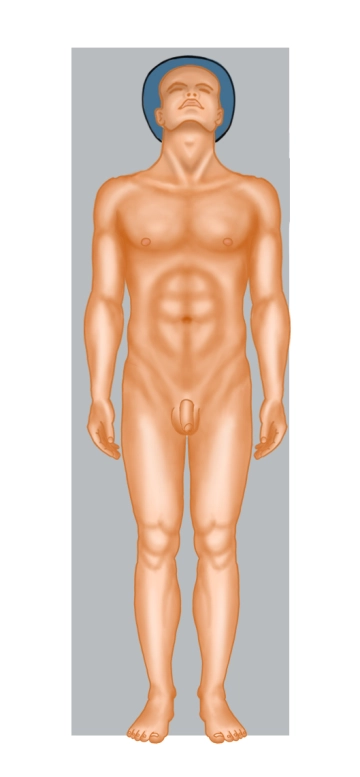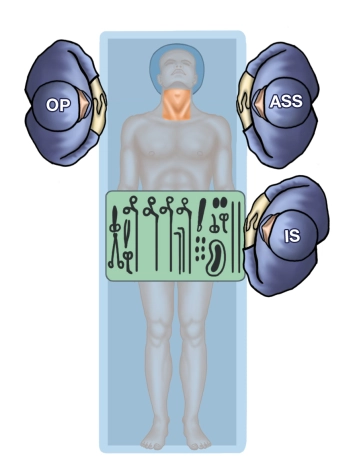Any laboratory chemical detection of a primary hyperparathyroidism (pHPT)
Urgent surgical indication after hypercalcemic crisis
- The term pHPT describes by definition the primary autonomous hypersecretion of parathyroid hormone from one or more parathyroid glands (PTG). It must be distinguished from the secondary form as a result of an underlying disease associated with hypocalcemia (vitamin D deficiency, chronic renal insufficiency).
- A pHPT occurs sporadically or hereditarily, usually in the context of multiple endocrine neoplasia (MEN).
Pathophysiology
The hormonal control of calcium levels is primarily regulated by parathyroid hormone (PTH, synthesis in the parathyroid glands) and vitamin D3 (1,25-dihydroxycholecalciferol, synthesis of the active metabolite in the proximal tubules of the kidneys). The secretion of PTH by the parathyroid glands is inversely regulated. A slight increase in serum calcium concentration and the associated activation of the CaSR result in inhibition of PTH secretion. Conversely, a low calcium concentration stimulates the synthesis and secretion of PTH. In patients with pHPT, the normal regulation of PTH secretion is disrupted. Despite an elevated serum calcium concentration, these patients exhibit disproportionately high PTH levels and suffer primarily from the consequences of the resulting hypercalcemia.
Epidemiology
In pHPT, a solitary parathyroid adenoma is found in 85 - 90% of cases, women are affected 3 - 4 times more frequently than men. The disease is usually diagnosed between the ages of 55 and 75.
This must be distinguished from multi-gland disease, which usually has a genetic cause. These hereditary forms must be identified or distinguished. Hereditary primary hyperparathyroidism (hpHPT) often affects multiple glands either as diffuse hyperplasia or in the form of multiple adenomas.
About 2 - 5% of all pHPT cases occur in the context of multiple endocrine neoplasia type 1 (MEN 1) with equal frequency in women and men at an early age.
pHPT is the leading diagnosis in MEN 1 and is observed almost regularly. Although MEN 4 affects the same primary organs as MEN 1 (parathyroid glands,pancreas and pituitary gland), patients usually present later in life and have a more indolent disease course than patients with MEN 1. Most patients with MEN 4 and hyperparathyroidism have single parathyroid adenomas, while in MEN 1 all four parathyroid glands are hyperplastic. MEN 4 is much rarer than MEN 1.
In MEN 2a with leading tumor medullary thyroid carcinoma, pHPT occurs in 15 - 10%.
In < 1 % of cases, there is a parathyroid carcinoma: Often younger patients with severe pHPT, association with syndromic diseases, e.g. familial HPT-jaw tumor syndrome: This disease is characterized by severe pHPT and tumors in the jaw bones. In this disease, the PTG tumors are malignant in 15 - 30% of cases.
The presentation of pHPT has changed in the last three decades from a highly symptomatic disease to an incidentally discovered hypercalcemia, particularly due to the easy availability of laboratory diagnostics. The diagnosis of pHPT is made at least 10 years earlier today than 20 years ago.
Surgery
Surgery is the only curative therapy; practically all patients with proven pHPT benefit from surgery. Due to the morbidity spectrum of hypercalcemia, parathyroidectomy is indicated not only in symptomatic forms but also in asymptomatic cases as a rule.
Preoperative detection of a single enlarged parathyroid gland enables a focused surgical approach.
The standard procedure for solitary adenoma is the open minimally invasive parathyroidectomy demonstrated here as the initial procedure for localized pHPT, usually combined with histological frozen section examination and intraoperative PTH monitoring. If the adenoma has been localized preoperatively concordantly with ultrasound and scintigraphy, intraoperative monitoring of the PTH level can be omitted.
Through a 2 - 3 cm long skin incision, the affected parathyroid gland is removed in a focused manner. The procedure takes place exclusively in one thyroid lobe. Due to the anatomical location, resection of an upper parathyroid gland is more difficult than that of a lower one. If the adenoma is not found or the PTH level does not drop, bilateral exploration must be performed and all four parathyroid glands identified.
In case of suspicion of a carcinoma, possibly extension by en-bloc resection of adjacent structures (hemithyroidectomy, straight neck muscles, soft tissue). Lymphadenectomy only if suspicious lymph nodes are detected.



